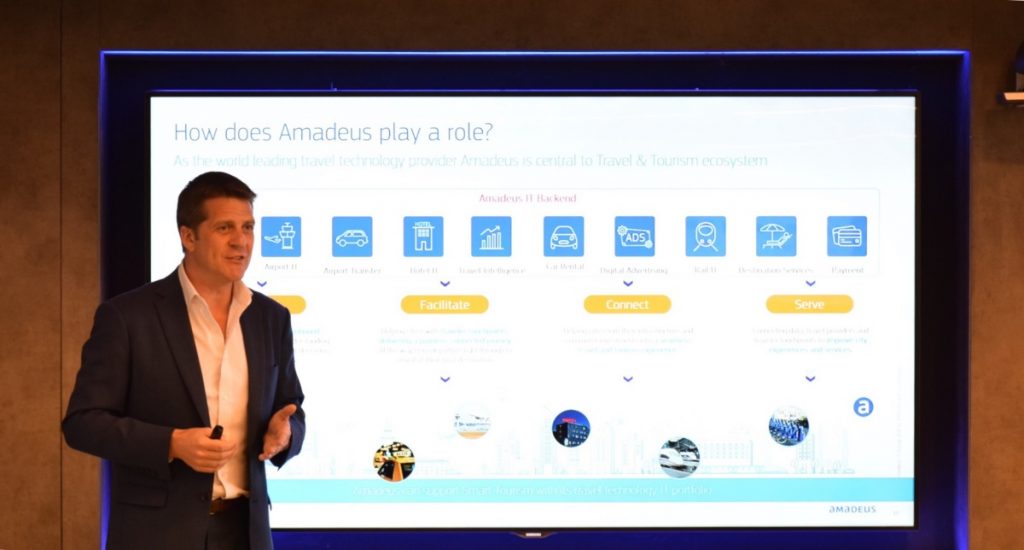Amadeus, depa and PATA unveil roadmap for future-proofing Thailand’s tourism industry
Thailand must invest in a central strategy to make its travel and tourism infrastructure smarter if it is going to continue to grow tourism revenue in the next decade, according to a new report released today by travel technology company Amadeus in partnership with Thailand’s Digital Economy Promotion Agency (depa) and the Pacific Asia Travel Association (PATA).
 Thailand’s travel and tourism sector grew by 6.0% last year. However, according to the ‘Thailand Towards 2030: Future of Travel & Tourism’ report, a number of the country’s airports are approaching capacity and popular destinations are starting to show the impact of ‘over’ tourism, both of which could limit the rate of future tourism growth if not urgently addressed.
Thailand’s travel and tourism sector grew by 6.0% last year. However, according to the ‘Thailand Towards 2030: Future of Travel & Tourism’ report, a number of the country’s airports are approaching capacity and popular destinations are starting to show the impact of ‘over’ tourism, both of which could limit the rate of future tourism growth if not urgently addressed.
The report identifies four key priority areas for Thailand in the next decade – increasing airport capacity; improving inter-modal air-to-city links; scaling up public-private partnerships to improve the efficiency of inner-city transport networks; and reducing ‘over’ tourism – all of which will depend on the adoption of smart technologies.
Increasing airport capacity by improving operations for passengers
 Thailand received a record 38.27 million tourists in 2018 and Thailand’s Tourism Ministry expects that number to be even higher in 2019, driven partly by rising incomes across the Asia Pacific region. However, the ‘Thailand Towards 2030: Future of Travel & Tourism’ report warns that, in addition to planned physical expansions, Thailand’s airports will also need to change how passengers move through the terminal in order to increase their capacities and fully profit from this opportunity in the next decade.
Thailand received a record 38.27 million tourists in 2018 and Thailand’s Tourism Ministry expects that number to be even higher in 2019, driven partly by rising incomes across the Asia Pacific region. However, the ‘Thailand Towards 2030: Future of Travel & Tourism’ report warns that, in addition to planned physical expansions, Thailand’s airports will also need to change how passengers move through the terminal in order to increase their capacities and fully profit from this opportunity in the next decade.
“If tourism continues to grow at its current rate, I’d expect Thailand’s airports to hit capacity even sooner than is currently forecast. Physical expansion is helping to ease some of the strain, but smart technology will also be vital to increase the number of passengers that Thailand’s airports can accommodate in the near future,” said Dr. Mario Hardy, Chief Executive Officer, PATA.
The report identifies self-serve check-in kiosks, automated bag-drop and use of biometrics for passenger identification as technologies that could significantly increase the efficiency of passenger movements. It also advises that off-airport check-in and bag-drop services – which use cloud technology to allow passengers to check into their flight and even deposit their luggage outside the terminal building – should be considered by Thailand’s busiest airports.
 Extending inter-modal air-to-city links to accelerate MICE growth
Extending inter-modal air-to-city links to accelerate MICE growth
The report identifies the MICE (Meetings, Incentives, Conferences and Exhibitions) market – and the related trend of ‘bleisure’ travel, where visitors coming for business extend their stay for leisure – as two significant opportunities for Thailand to diversify its tourism revenue in the next decade.
As well as developing direct airport-to-conference center rail connections to accelerate the MICE industry’s growth in emerging hot spots such as Khon Kaen, Pattaya, Chiang Mai, Phuket and Chiang Rai, the report advises that MICE destinations should also try to dovetail their rail and air schedules with typical conference start and finish times to encourage growth of the bleisure market too.
Report co-author Simon Akeroyd, Vice President Corporate Strategy & Business Development, Amadeus, also recommends that Thailand’s MICE destinations need technologies that support a seamless travel experience to effectively compete internationally.
“Ease and speed of travel will become major differentiators amongst the region’s MICE hot spots in the near future, so these cities need to invest in technologies that are designed for convenience – such as having off-airport check-in and bag-drop facilities at conference venues themselves. The technology needs to be best-in-class because Thailand is competing with MICE destinations across the region, not just domestically,” he said.
Scaling up public-private partnerships to improve inner-city travel
Smart mobility solutions – where data and technology are integrated to improve the efficiency of population movements around a city – are another priority area identified by the ‘Thailand Towards 2030: Future of Travel & Tourism’ report to reduce congestion and pollution in Thailand’s cities, and ultimately make them more attractive to both tourists and business investment.
“Smart mobility is still in its infancy in Thailand, but its potential to improve inner-city travel is enormous,” said Amadeus’ Simon Akeroyd. “Using transport data to inform travel management systems like traffic lights in real-time, or to inform how ‘sharing economy’ services like Grab and Get are deployed, are just two significant applications. But this won’t be possible without greater public-private sector partnerships.”
According to the report, one major challenge is that Thailand’s public sector doesn’t currently know which companies to partner with, whilst private firms, especially smaller businesses, start-ups and overseas investors, often don’t know how to engage, so third-party advisers may be important in bringing key players together.
depa identifies access to capital as another barrier in Thailand and recommends that cities will need to form ‘City Development Companies’ with private sector partners in the future – to better bid for funding and to formalize the nature of their partnership.
“Right now, we’re only just scratching the surface of what’s possible with smart mobility. More provinces need to follow the City Development Company model being piloted by Phuket, Chiang Mai and Khon Kaen to access vital funding and plan for the long term,” said Pracha Asawateera, Vice President Southern District Office, Digital Economy Promotion Agency.
Minimizing the negative impact of tourism for a sustainable future
The final priority identified by the report is the need for more action to be taken to protect Thailand’s tourist hot spots from the risks of ‘over’ tourism.
Amadeus, depa and PATA agree that giving tourism boards, local authorities and hospitality businesses access to accurate data for real-time analysis and predictive modelling will be integral to managing tourism in a more sustainable way in the future but, like smart mobility, this is still in its infancy in Thailand too.
“The data exists, but Thailand’s tourism industry isn’t quite there yet in using it effectively to manage peak periods. Education on how to interpret and use the data will be just as important as access. Done well, the potential is for the data to be used not only to control tourist numbers, but also to inform everything from ticket prices to infrastructure investments and long-term tourism policies,” said PATA’s Dr Mario Hardy.
For more information, and to download a full copy of the ‘Thailand Towards 2030: Future of Travel & Tourism’ report, visit https://amadeus.com/en/insights/research-report/thailand-towards-2030.
ลงทะเบียนเข้าสู่ระบบ เพื่ออ่านบทความฟรีไม่จำกัด






